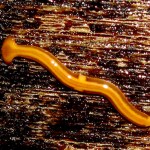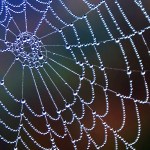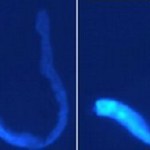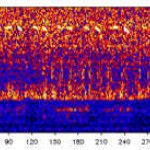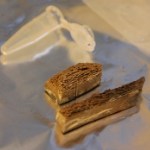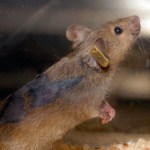Life Science
Meet the first newly discovered mammalian species in 35 years, the olinguito, as presented by Rob Nelson from Untamed Science:
Figure from Journal of Experimental Biology.
Researchers Tal Shomrat and Michael Levin at Tufts University have found that planaria worms are able to quickly relearn lost skills after literally losing their heads. The researchers trained the worms to find food in an environment with bright light and open space, both considered uncomfortable to the creatures. The time it took for worms to adjust to the environment and find food was recorded. Then, the researchers severed their heads and waited for the head and brain to regenerate (see image above). What…
Image of wet spider web from www.photoforum.com
The US Navy has decided to sponsor research conducted by Dr. Randy Lewis, a specialist in spider silk, at Utah State University. Their interest in the research lies in the ability for spider silk to maintain adhesiveness even under wet conditions. Therefore, Navy officials are seeking to create a synthetic spider silk that they can manufacture for use as an underwater adhesive.
Source:
Utah State University
Kai, a dolphin involved in the study, was able to recognize the whistle of a fellow dolphin that Kai had not seen in years. Image by: Jason Bruck
Another reason to marvel at dolphins. As a follow up to the previous blog on dolphins calling each other by name, new research from Dr. Jason Bruck at the Institute for Mind and Biology (University of Chicago) shows that dolphins have the longest memory known in animals. In addition to Kai, shown above, a dolphin named Bailey recognized the whistle of Allie, even though they had not seen each other in more than 20 years! I am fairly…
Image of creme brulee by Moniza, from www.allrecipes.com
Researchers at the University of Washington have shown that a trace component in burnt sugar (like the creme brulee above) and Caramel Colour III (used to color dark beers, brown sugar, etc) has been shown to help regenerate muscles in both fruit fly and mouse models of Duchenne muscular dystrophy.
Drs. Morayma Reyes (Professor of Pathology and Laboratory Medicine) and Hannele Ruohola-Baker (Professor of Biochemistry; Associate Director of the Institute for Stem Cell and Regenerative Medicine) studied mouse models that…
I just watched a neat video describing how animals adapt to their environments to increase survival:
A drug currently used to treat colon cancer in people successfully treated a type of brain tumor, called a glioma, in a dog named "Petey". After removing the tumor, Dr. Simon Platt administered the drug to the brain where it prevented the tumor from returning. The next step is to conduct a larger study that includes more dogs. If successful, the drug may be used in clinical studies of humans to treat glioblastomas, a similar form of brain cancer that affects roughly 13,000 people annually and for which there is currently no cure.
A fly landing in the ear of a tourist visiting Peru turns out to be more than just annoying. The screwworm fly had sufficient time to lay eggs that hatched flesh-eating maggots in her ear canal.
Warning: the video may be disturbing to some viewers
As strange as this sounds, it is not that uncommon
Fortunately the screwworm fly has been effectively eradicated in the United States since the 1960's by releasing sterile male flies resulting in fewer and fewer offspring. This work was conducted by the USDA as you can imagine how this fly would decimate livestock.
Dying nematode worm. Image: Cassandra Coburn
Dr. Gems, University College London, and colleagues were studying aging using nematode worms. They discovered that dying nematode worms emit a wave of blue light from dying cells. It was previously thought that damaged components of aging cells collect in lysosomes forming what they call lipofuscin, which fluoresces. His team refuted that long-held belief and showed that the dying light was produced instead by anthranilate, a substance that is inactive in the acidic environment of the gut but becomes activated when cells die (necrosis) and…
Image of Canis lupus by Gary Kramer, from US Fish & Wildlife Service.
Researchers have designed a computer program that can identify an individual wolf in the wild analyzing the frequency and amplitude of their howls. They were able to accurately identify an individual Eastern grey wolf (Canis lupus lycaon) with 97% accuracy using the program. This program is expected to be highly useful to wolf biologists and conservationists.
This program would certainly make camping more entertaining as well.
Source:
Root-Gutteridge H, Bencsik M, Chebli M, Gentle LK, Terrell-…
Image of bottlenose dolphin pod from www.deography.com, Dylan O'Donnell 2010
A new study published in the Proceedings of the National Academy of Sciences provides evidence that bottlenose dolphins (Tursiops truncatus) use "signature whistles" to identify and call each other by "name".
Dr. Vincent Janik at the Scottish Oceans Institute, University of St. Andrews and colleagues recorded the individual whistles of wild bottlenose dolphins traveling in groups (pods). Using the recordings, they developed computerized versions of the whistles that were missing the vocal…
Image from: Noa Safra, UC Davis
Weimaraner dogs are helping researchers to understand neural tube birth defects, like anencephaly (where the brain or skull do not fully develop) and spina bifida (where the spinal column is not fully enclosed). In new research published this week in PLOS One, Dr. Noa Safra (UC Davis, School of Veterinary Medicine) and colleagues mapped the genomes of Weimaraner dogs that had spinal dysraphism, a neural tube defect, along with samples from humans with spina bifida. They discovered mutations in a gene called NKX2-8 that is known to be…
Image of the 52 Hertz whale song from Wikimedia Commons, NOAA.
According to Discovery News, scientists and filmmakers are on the hunt for what people have called the Loneliest Whale in the World.
In 1989 William Watkins (Woods Hole Oceanographic Institution) discovered the vocalizations of a whale that were unlike that of any other whale. The vocalizations of the mystery whale were 52 Hertz whereas other whales sing in the 17-18 Hertz range, allowing their songs to travel far distances. Beginning in 1992, he and his team started tracking the movements of the 52 Hertz whale using…
Image from www.KidsHealth.org
Babies born prematurely are predisposed to necrotizing enterocolitis, in which portions of the intestinal lining dies. Infant formulas are thought to contribute to the development of this disorder in premature babies. This is a serious condition that can lead to death in about 25% of premies.
Dr. Sangild (University of Copenhagen) and colleagues have discovered that premature piglets that were fed either human donor breast milk or bovine (cow) colostrum had better outcomes compared to those fed infant formula. Food passage time through the intestines was…
Ever wonder what dogs and hyenas have in common? Would you be surprised to learn that hyenas are more closely related to cats than dogs? In fact, according to this video thesis, the shared bone-crushing abilities of dogs and hyenas is actually an example of convergent evolution.
I am currently watching a re-run of the NOVA special called Dogs Decoded. If you have not already seen it, you should check it out! It was actually the subjects of a prior blog that you can read here.
Bone fragments used for sequencing the ancient horse genome. Image credit: LUDOVIC ORLANDO as published in The Scientist.
Researchers have successfully created a draft sequence of the complete genome of a 700,000 year old horse from a bone fragment extracted from permafrost in the Yukon Territory (Canada). This is the oldest specimen ever sequenced by almost 10-fold. Prior sequencing of the whole genome from a hominid from Siberia who lived 80,000 years ago was the prior record holder.
It is amazing to me that they were able to recover the entire genome from such an old specimen! These…
Dogs, like people, are susceptible to a form of obsessive compulsive disorder (OCD) known as canine compulsive disorder (CCD). In fact, the news story at the end of this blog describes CCD and also discusses a form of OCD in Siamese and Persian cats that is related to stress.
A prior study suggested that dogs are good models for OCD in humans since their physiology is similar and they share the same environment as humans. Dr. Hannes Lohi (University of Helsinki) and colleagues found that dogs who received vitamin and mineral supplements were less likely to exhibit CCD (measured as excessive…
I am thrilled that Comparative Physiologist Dr. Jessica Meir, who was featured in a prior post, has been chosen as a 2013 Astronaut Candidate by NASA! I really enjoyed learning more about her life story in this video and I am looking forward to hearing more about her accomplishments as an Astronaut in the years to come.
Congratulations Dr. Meir and the rest of the 2013 Astronaut Candidates!
Dr. Meir's introduction as a candidate is at 10:30. Listen to her speak about being chosen at 28:50.
Click on this link for an article about Dr. Meir published yesterday in the Boston Globe.
Image of common model organisms from European Molecular Biology Laboratory (EMBL).
A recent article posted in the BBC News provided a good explanation of why scientists commonly study these organisms as models for human diseases and conditions. Model organisms are chosen because their physiology is similar to other animals, including humans, in addition to other reasons:
Visit the BBC News to see why researchers most often use flies, fish, mice and worms to understand the mechanisms of disease and health.
Did you know that ~70% of the genes in a…
